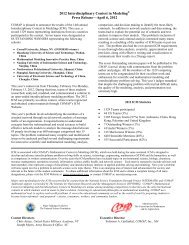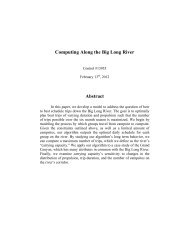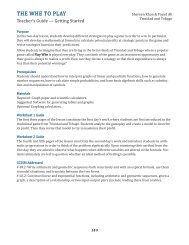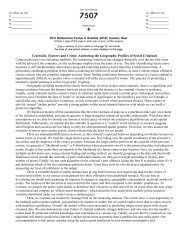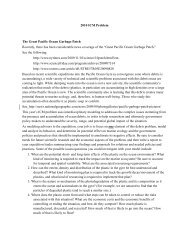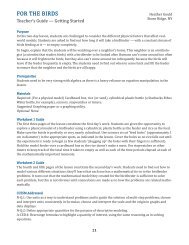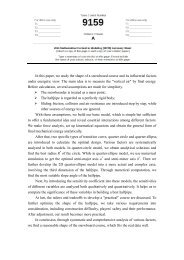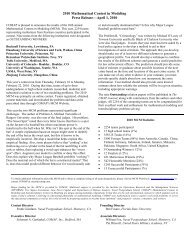Team 13074: Best schedule to utilize the Big Long River
Team 13074: Best schedule to utilize the Big Long River
Team 13074: Best schedule to utilize the Big Long River
You also want an ePaper? Increase the reach of your titles
YUMPU automatically turns print PDFs into web optimized ePapers that Google loves.
team<strong>13074</strong><br />
page 4of20<br />
trips occupy <strong>the</strong> same campsite at <strong>the</strong> same day. We divide <strong>the</strong> <strong>schedule</strong> problem<br />
in<strong>to</strong> three subparts. First (see 5.2.1) we assign a specific set of campsites <strong>to</strong> every<br />
type of trips and no two different campsite sets intersect, <strong>the</strong>n we only need <strong>to</strong> find<br />
<strong>the</strong> best <strong>schedule</strong> of every type of trip within corresponding campsite set. Second<br />
(see 5.2.2) we discuss <strong>the</strong> situation where Y is relatively small, and we continue <strong>the</strong><br />
idea by assigning a specific campsite set <strong>to</strong> every group of trip types. The <strong>schedule</strong>s<br />
for <strong>the</strong> situations where one group contains two and three trip types are given<br />
respectively. Third (see 5.2.3) we fur<strong>the</strong>r develop <strong>the</strong> idea <strong>to</strong> only divide in<strong>to</strong> two<br />
campsite sets for <strong>the</strong> case when Y is very small. Finally we finish <strong>the</strong> discussion of<br />
best <strong>schedule</strong> for different values of Y and come up with an exact <strong>schedule</strong> when<br />
Y=150 in 5.2.2.<br />
Chart2 brief description of <strong>the</strong> model<br />
Note for brief description of <strong>the</strong> model, we will denote every specific campsite set<br />
with <strong>the</strong> word “orbit” throughout <strong>the</strong> paper.<br />
5.2 Development of <strong>the</strong> model<br />
To begin with, we find out <strong>the</strong> number of trip types available.<br />
As for every trip type i, we calculate <strong>the</strong> average time needed for driving <strong>the</strong> ship per<br />
day and denote it withA i . According <strong>to</strong> assumption 4.4 (Passengers drive <strong>the</strong> ship<br />
at most 8 hours a day), <strong>the</strong> trip type is possible iff A i ≤ 8. Therefore trip type 1<br />
(oar-powered, 6 days) and trip type 3 (oar-powered, 7 days) are crossed out. But<br />
here we allow <strong>the</strong> trip type 3 in <strong>the</strong> <strong>schedule</strong> <strong>to</strong> maximize <strong>the</strong> <strong>to</strong>tal number of trips,<br />
since A 3 = 225<br />
= 8.03 is really close <strong>to</strong> 8.<br />
4∗7<br />
Consequently <strong>the</strong>re are al<strong>to</strong>ge<strong>the</strong>r 25 trip types available.<br />
5.2.1 Every campsite set for every single trip type<br />
We will discuss <strong>the</strong> situation where Y is big enough here.<br />
(ⅰ)Dividing in<strong>to</strong> separate campsite sets<br />
We now have 25 trip types and we assign <strong>the</strong>m with campsite sets using a ra<strong>the</strong>r<br />
simple way. Put <strong>the</strong> campsites whose remainders divided by 25 are <strong>the</strong> same in<strong>to</strong><br />
one campsite set and sequentially assign <strong>the</strong> 25 campsite sets <strong>to</strong> 25 trip types.<br />
Therefore every campsite set contains<br />
Y<br />
25 campsites.<br />
As we can see from <strong>the</strong> chart below, <strong>the</strong> distance between two adjacent campsites in







